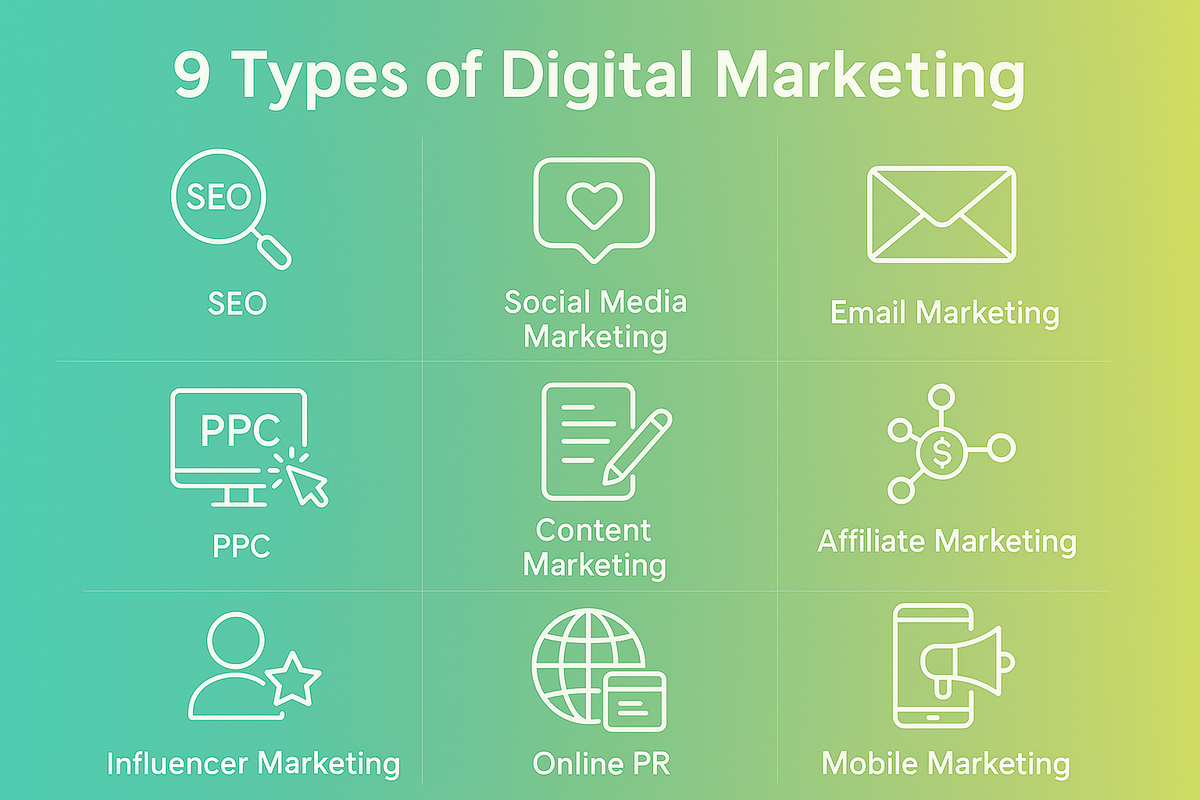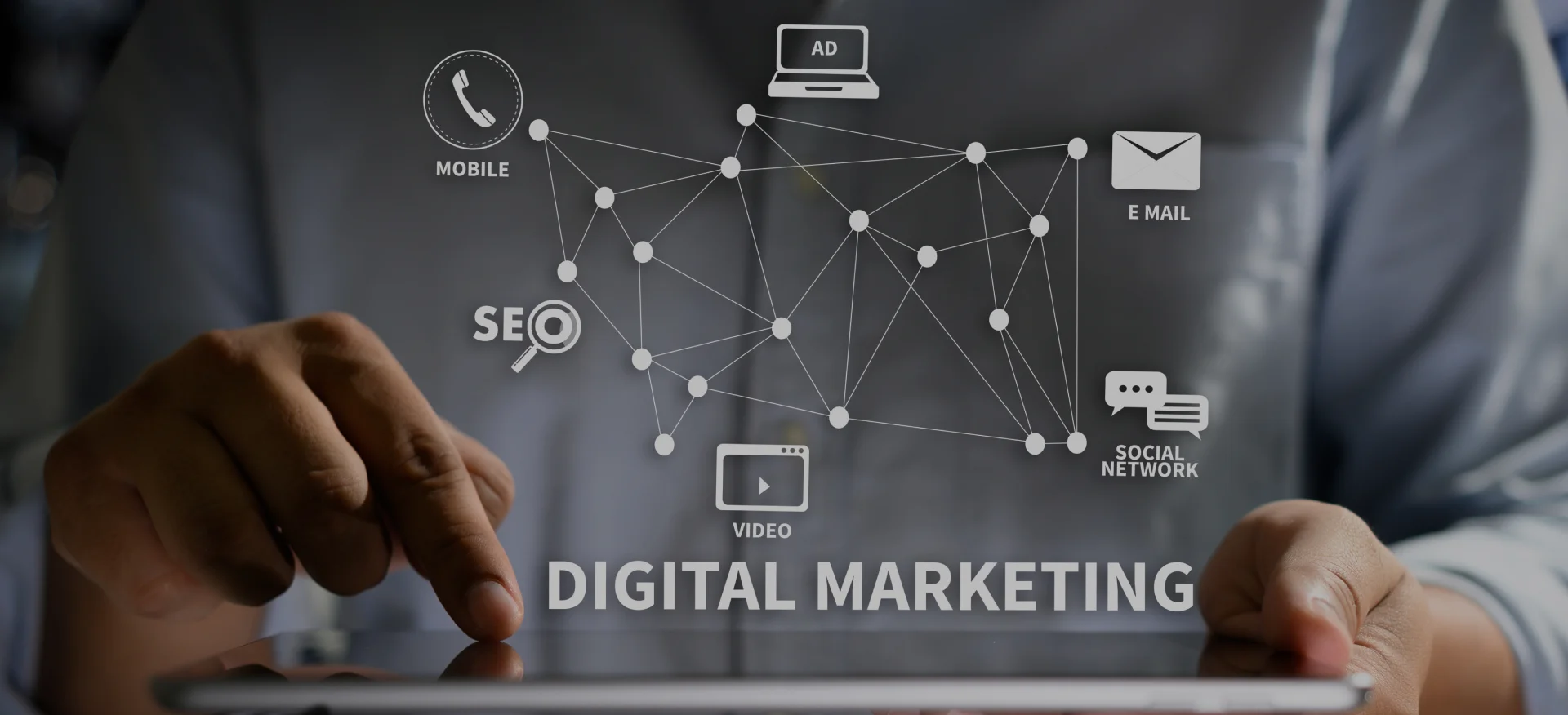Digital marketing is the practice of promoting products, services, or brands through various online channels, including websites, social media, search engines, email, and mobile apps.
Digital marketing allows businesses to reach their target audience directly, build brand awareness, and generate leads in a cost-effective and measurable way.
The key benefits of digital marketing are its broad reach, cost-efficiency, and ability to measure performance.
Unlike traditional marketing methods, digital marketing enables businesses to target a global audience while staying within budget.
Small and medium-sized businesses can compete with larger companies by utilizing tools that offer better ROI.
Some of the primary digital marketing channels include SEO (Search Engine Optimization), social media marketing, email marketing, content marketing, and paid advertising.
For example, what are five marketing strategies that retailers spend half of their annual budget on? with consumers through digital platforms, adopting a strong digital marketing strategy has become essential for staying competitive.
Knowing how to do digital marketing effectively allows businesses to reach their target audience directly, build brand awareness, and generate leads in a cost-effective and measurable way.
The key benefits of digital marketing are its broad reach, cost-efficiency, and ability to measure performance.
Many retailers invest heavily in paid ads, social media promotions, and email campaigns. Understanding these strategies helps businesses allocate their resources effectively.
In this guide, we will explore everything you need to know about digital marketing.
What is Digital Marketing?
Digital marketing is the practice of utilizing various digital channels, platforms, and technologies to promote and advertise products, services, or brands. It involves leveraging the power of the internet and electronic devices, such as computers, smartphones, and tablets, to connect with a specific target audience.
Digital marketing encompasses a wide range of online marketing activities, including search engine optimization (SEO), content marketing, social media marketing, email marketing, pay-per-click advertising, and affiliate marketing. What is the difference between OneDrive and SharePoint is important to understand for businesses that rely on cloud storage for sharing and managing documents.
For instance, what is the digital marketing strategy that tracks users across the web? It’s known as retargeting or remarketing, which helps to engage potential customers who have previously interacted with your website or ads, much like understanding How To Train An AI Model to predict user behavior.
The goal is to increase visibility, drive traffic, and engage consumers in a way that encourages them to take desired actions, whether it’s making a purchase, signing up for a newsletter, or interacting with a brand. In What is Sports Marketing, this could involve engaging fans through personalized, interactive campaigns on sports platforms.
Through data analytics and real-time performance tracking, digital marketing also allows businesses to measure and optimize their campaigns for better results and higher return on investment.
3 Key Benefits for Businesses
Digital marketing offers several advantages for businesses, particularly in terms of reach, cost-effectiveness, and measurability
- Reach: Digital marketing allows businesses to connect with a global audience, breaking down geographical barriers and providing access to a wider pool of potential customers.
- Cost-effectiveness: Compared to traditional marketing methods like TV or print ads, digital marketing offers more affordable solutions with higher ROI. Small businesses can compete with larger companies through targeted online campaigns.
- Measurability: One of the biggest advantages of digital marketing is the ability to track and measure the effectiveness of campaigns in real-time. This data helps businesses understand customer behavior, adjust strategies, and improve results.
Additionally, using SEO tools such as best SEO reporting tool can provide valuable insights into website traffic and keyword performance, making it easier to track how marketing campaigns are performing.
Explore Our Digital Marketing Services!
9 Types of Digital Marketing
Digital marketing has revolutionized how businesses connect with their audience. By leveraging various strategies and platforms, companies can enhance visibility, drive engagement, and boost conversions.

Main types of digital marketing are as follows:
- Search Engine Optimization (SEO): Improving website visibility on search engines like Google.
- Social Media Marketing: Promoting content on platforms like Facebook, Instagram, Twitter, and LinkedIn to engage with customers.
- Email Marketing: Sending targeted messages to users via email to nurture relationships and drive sales.
- Pay-Per-Click Advertising (PPC): Running ads on search engines or social media platforms where businesses pay each time their ad is clicked.
- Content Marketing: Creating and distributing valuable, relevant content to attract and engage an audience.
- Affiliate Marketing: Partnering with individuals or companies to promote your product or service and earn a commission.
- Influencer Marketing: Collaborating with influential people to promote products or services.
- Online Public Relations: Managing a company’s reputation and promoting its image online.
- Mobile Marketing: Optimizing marketing strategies for mobile devices, such as apps, text messages, or mobile-friendly websites. A focus on mobile search optimization is key to ensuring your business ranks well on mobile devices.
The goal of digital marketing is to connect with potential customers, build brand awareness, drive traffic, generate leads, and ultimately, increase sales, all through online channels.
Key Performance Indicators (KPIs) for Digital Marketing Channel
KPIs are the metrics you monitor to gauge the effectiveness of your digital marketing strategies. Different channels have distinct KPIs that give insight into specific areas of performance. Here's a breakdown of important KPIs to track across various online digital marketing channels:
SEO (Search Engine Optimization)
SEO is all about increasing visibility on search engines. Tracking performance on search engines helps you gauge whether your SEO efforts are yielding the desired results.
1. Organic Traffic
- What it is: The number of visitors who arrive at your website through organic (non-paid) search results.
- Why it matters: It indicates the overall visibility and reach of your website on search engines like Google.
- How to track it: Use tools like Google Analytics or SEMrush to track organic search traffic over time.
2. Bounce Rate
- What it is: The percentage of visitors who land on your website but leave without interacting with any other pages.
- Why it matters: A high bounce rate could signal that your landing pages are not engaging or relevant to the visitors.
- How to track it: Google Analytics tracks bounce rate for each page on your website.
3. Keyword Rankings
- What it is: Your position on search engines for specific keywords.
- Why it matters: Tracking how well your pages rank for targeted keywords allows you to measure SEO success and identify opportunities for improvement.
- How to track it: Use tools like Google Search Console or SEMrush to track keyword rankings and identify pages that need optimization.
PPC (Pay-Per-Click)
PPC campaigns (e.g., Google Ads) are designed to drive traffic through paid ads. Here are the KPIs you should monitor to measure the success of your paid advertising efforts.
1. Click-Through Rate (CTR)
- What it is: The percentage of people who clicked on your ad after seeing it.
- Why it matters: A high CTR means your ad copy and targeting are compelling and relevant to your audience.
- How to track it: Track it via your Google Ads account or whichever paid advertising platform you’re using.
2. Conversion Rate
- What it is: The percentage of visitors who take a desired action (e.g., make a purchase, sign up for a newsletter) after clicking on your ad.
- Why it matters: It indicates the effectiveness of your landing page and ad copy in persuading users to take action.
- How to track it: Set up conversion tracking in Google Ads or other platforms to track completed actions.
3. Cost Per Click (CPC)
- What it is: The average amount you're paying for each click on your ad.
- Why it matters: It helps assess the efficiency of your ad spend. A low CPC with a high conversion rate is ideal.
- How to track it: Track CPC through your ad platform (e.g., Google Ads).
Email Marketing
Email remains one of the most effective ways to reach and engage your audience. These KPIs will help you monitor and improve your email campaigns.
1. Open Rate
- What it is: The percentage of recipients who open your email.
- Why it matters: A low open rate could indicate that your subject lines are not compelling or that your emails are ending up in the spam folder.
- How to track it: Email marketing platforms like Mailchimp, HubSpot, or ActiveCampaign track open rates for each email.
2. Click-Through Rate (CTR)
- What it is: The percentage of recipients who click on links within your email.
- Why it matters: This indicates how engaging your email content is and whether it is prompting recipients to take action.
- How to track it: Again, this is tracked within email platforms like Mailchimp or HubSpot.
3. Unsubscribe Rate
- What it is: The percentage of recipients who opt out of your email list after receiving an email.
- Why it matters: A high unsubscribe rate may indicate that your content is not resonating with your audience or that you are sending emails too frequently.
- How to track it: Most email marketing platforms provide this data in their reporting dashboard.
Social Media Marketing
Social media platforms are crucial for brand awareness and engagement. The KPIs for social media marketing allow you to measure how well your content is performing on platforms like Facebook, Instagram, LinkedIn, and Twitter.
1. Engagement Rate
- What it is: The total number of interactions (likes, comments, shares) divided by the total number of followers, then multiplied by 100 to get a percentage.
- Why it matters: It measures how much your audience is interacting with your posts and whether your content is engaging.
- How to track it: Track engagement through the analytics tools built into social platforms like Facebook Insights or Instagram Analytics.
2. Follower Growth
- What it is: The rate at which your social media following is growing over time.
- Why it matters: It shows whether your social media presence is gaining traction and how well you’re attracting new followers.
- How to track it: Monitor growth via platform-specific insights (e.g., Twitter Analytics, Facebook Insights).
3. Conversion Rate
- What it is: The percentage of social media followers who take a desired action (e.g., click on a link, make a purchase, fill out a form) after engaging with your social media posts.
- Why it matters: It helps measure the effectiveness of social media campaigns in driving real business results.
- How to track it: Use UTM tracking links to monitor conversions from social media platforms in Google Analytics.
Best 5 Tools for Tracking and Analyzing Performance
To collect, analyze, and act on data, you need the right tools.
![]()
Here are some of the best platforms for tracking performance across digital marketing channels:
1. Google Analytics
- What it is: A free tool that tracks website traffic, user behavior, conversions, and more.
- Why it matters: It helps you understand how visitors are interacting with your site, where they come from, and what content they engage with the most.
- How to use it: Set up Google Analytics on your website to track key metrics like organic traffic, bounce rate, and conversions. Customize reports to track specific KPIs.
2. SEMrush
- What it is: A paid platform designed for tracking SEO performance, keyword rankings, and competitive analysis.
- Why it matters: SEMrush provides insights into which keywords are driving traffic to your website, helps you track competitors' performance, and audits your site for SEO issues.
- How to use it: Use SEMrush for keyword research, backlink analysis, and monitoring your SEO progress over time.
3. HubSpot
- What it is: A complete inbound marketing tool that tracks email campaigns, social media performance, and website analytics.
- Why it matters: HubSpot allows you to track leads and customer interactions across multiple touchpoints, providing a holistic view of your marketing efforts.
- How to use it: Use HubSpot to create, schedule, and track the performance of email campaigns, social media posts, and blog content.
4. Hootsuite/Buffer
- What it is: Tools for scheduling, managing, and analyzing social media content.
- Why it matters: These platforms allow you to schedule posts across multiple social channels, track engagement, and generate reports to assess the performance of your social media campaigns.
- How to use it: Use Hootsuite or Buffer to plan and schedule social media posts in advance, track metrics like engagement and follower growth, and analyze post performance.
5. Google Ads
- What it is: A platform for managing and analyzing paid advertising campaigns, including search ads, display ads, and YouTube ads.
- Why it matters: Google Ads provides detailed reports on CTR, CPC, conversion rates, and other metrics for paid campaigns.
- How to use it: Use Google Ads to monitor ad performance, optimize campaigns based on CTR and conversion data, and control your PPC budget.
7 Steps to Craft a Digital Marketing Strategy
Executing an effective digital marketing strategy involves setting clear goals, understanding your audience, leveraging the right channels, and continuously optimizing campaigns to drive measurable results.
1. Define Your Goals and Audience
Executing an effective digital marketing strategy starts with defining clear SMART goals specific, measurable, achievable, relevant, and time-bound.
Next, identify your target audience by defining demographics (age, gender, location, income) and psychographics (interests, values, behaviors).
Understanding what is B2C sales (Business-to-Consumer sales) is also key, as this helps tailor your marketing strategy towards individual consumers rather than businesses.
Understand the customer journey stages:
- Awareness: Introduce your brand
- Consideration: Evaluate your offerings
- Decision: Make the purchase or commitment
2. Build a Strong Online Presence
To build a strong online presence, start by creating and optimizing your website. Ensure that it is mobile-friendly, SEO-optimized, and fast-loading to improve user experience and search engine rankings.
A website that performs well across devices and loads quickly can enhance your credibility and keep visitors engaged.
Next, set up social media business profiles across key platforms like LinkedIn, Instagram, and others that align with your target audience.
A crucial step in learning how to do digital marketing is maintaining consistency in branding, messaging, and engagement across all channels.
Consistency is key, so maintain uniform branding, messaging, and engagement across all channels. Social media helps build brand recognition and engage directly with your audience.
Don’t forget to claim your business listings. This includes updating and managing profiles on platforms like Google Business Profile and relevant industry-specific directories.
This boosts your local visibility, making it easier for customers to find you when searching online.
3. Develop a Content Marketing Strategy
A solid content marketing strategy involves using various types of content, such as blog posts, videos, infographics, and podcasts.
This approach helps capture the attention of different audience segments. Creating and improving digital illustrations for your posts can also add a visual dimension, improving engagement.
Create a content calendar to ensure consistent delivery and maintain audience engagement.
- Focus on value-driven content that addresses customer pain points and provides practical solutions.
- Use storytelling to create emotional connections, helping your brand resonate more deeply with your audience.
4. Use Email Marketing for Nurturing
To build and maintain a strong relationship with your audience, start by building an ethical subscriber list. This can be achieved through lead magnets (e.g., free resources, ebooks) and opt-in forms on your website.
Make sure to gain permission before sending emails to ensure compliance with privacy regulations.
Next, create segmented campaigns by dividing your audience based on factors like interests, behaviors, and customer journey stages.
This enables you to send more relevant and personalized messages, which can increase engagement and conversion rates.
Personalize emails by customizing subject lines and content. Tailor your messaging to resonate with individual subscribers based on their previous interactions or preferences.
Finally, set up automated drip campaigns. These can include welcome emails, abandoned cart reminders, and re-engagement campaigns to nurture leads and keep your audience engaged over time.
Explore Our Email Marketing Services!
5. Explore Affiliate & Influencer Marketing
Consider collaborating with industry partners for affiliate marketing. Build strong relationships with industry leaders to promote your products or services, offering them a commission for each sale they refer.
Additionally, set up commission-based partnerships with affiliates. Offering attractive commissions can motivate affiliates to drive more sales and enhance your business's reach.
Leverage influencers for niche marketing.
Collaborating with influencers who have a dedicated following in your niche allows you to promote your products to a highly relevant audience, increasing the effectiveness of your marketing efforts.
6. Leverage Analytics and Data
Make sure to use Google Analytics and other insights tools to track traffic, conversions, and user behavior on your website. These metrics help you understand how visitors interact with your site and which strategies are working.
Track essential KPIs (Key Performance Indicators) such as ROI, CPA (Cost Per Acquisition), and conversion rates to measure the effectiveness of your digital marketing campaigns and adjust accordingly.
Additionally, utilize heatmaps and A/B testing to further optimize your website and campaigns. Heatmaps show you where visitors are clicking the most, while A/B testing helps you compare different versions of your content or ads to determine which performs better.
7. Optimize and Scale
Once you've identified strategies that work, measure what works and double down. Focus your efforts on high-performing tactics and scale them for even greater success.
Reallocate your budget to high-performing channels by investing more in platforms or methods that generate the highest return on investment (ROI). This ensures that you're maximizing your marketing dollars.
Lastly, continuously refine your messaging and campaigns. Keep optimizing your content, design, and targeting to further enhance engagement and conversions, ensuring sustainable growth for your business.
5 Steps to Build and Launch a Successful Digital Marketing Campaign
Follow this step-by-step guide to create and launch a successful digital marketing campaign across various marketing channels:
1. Define Your Marketing Objective
Start by setting clear goals. Determine whether you aim to drive website traffic, generate leads, or increase sales, as this will shape your digital marketing strategy.
Each goal requires different approaches, and aligning your strategy with your objectives ensures better outcomes.
2. Understand Your Target Audience
Use demographic data, behavior analysis, and audience segmentation to refine and identify the specific group you're targeting. This ensures your message reaches the right people.
For instance, partnering with a technology marketing agency could provide insights into targeting tech-savvy consumers more effectively, enhancing your campaign’s reach and impact.
3. Select the Right Marketing Platform
Choose the platform that best aligns with your goals and audience. Whether it’s social media, Google Ads, content marketing, or email campaigns, each platform offers different benefits and targeting capabilities.
4. Create Engaging Content
Develop content that speaks directly to your audience’s needs and interests. Whether you’re writing blog posts, designing social media ads, or crafting email campaigns, make sure your message is compelling and relevant.
For businesses looking to establish a strong online presence, web design and development services are essential in ensuring your website is user-friendly, mobile-optimized, and aligned with your content strategy.
5. Launch and Track Campaign Performance
Once your campaign is live, monitor key metrics like click-through rates, engagement, and conversion rates. Use real-time data from Google Analytics to track performance and make adjustments as needed to optimize and scale your efforts.
Future Outlook of Digital Marketing
The future of digital marketing is driven by evolving technologies and a deeper understanding of consumer behavior.
Artificial Intelligence (AI) and machine learning will play a pivotal role in optimizing marketing strategies. AI can predict consumer behavior, automate processes, and create highly personalized content.
The use of AI-powered chatbots, predictive analytics, and content automation will streamline customer interactions, making marketing campaigns more efficient and tailored to individual needs.
Brands will leverage these technologies to foster meaningful connections with their audiences and provide personalized experiences at scale.
As voice-activated devices like smart speakers continue to rise in popularity, voice search optimization will become an essential element of digital marketing strategies.
Brands will need to adapt their SEO tactics to optimize for conversational language and long-tail keywords.
Similarly, visual search, where consumers can search using images rather than keywords, will revolutionize e-commerce, allowing users to find products by uploading images.
This trend will require businesses to rethink their product displays and image-based content strategies.
Lastly, data privacy and regulations will shape the future of digital marketing.
With increasing concerns about data security and privacy, brands will need to be transparent and ethical in how they collect and use consumer data.
Future digital marketing efforts will focus on gaining consumer trust, being transparent with data practices, and using privacy-focused tools to maintain a competitive edge while respecting user rights.
This will lead to a shift towards more responsible and ethical marketing practices.
FAQs: How To Do Digital Marketing?
What Is Digital Marketing?
Digital marketing is the practice of promoting products, services, or brands through various online channels like websites, social media, email, and mobile apps. It enables businesses to reach a wider audience, build brand awareness, and drive engagement in a cost-effective and measurable way.
How Can I Get Started in Digital Marketing?
To get started in digital marketing, you should begin by learning the fundamentals of web marketing, including SEO, social media marketing, content marketing, and email campaigns. Consider taking online courses or certifications to build your knowledge. Then, create a plan that aligns with your business goals and start implementing digital marketing strategies to engage with your target audience.
What Is a Digital Marketing Strategy and Why Is It Important?
A digital marketing strategy outlines the plan to achieve specific marketing goals using digital channels. It includes selecting the right platforms, creating content, and defining KPIs to measure success. Having a solid digital marketing strategy helps businesses stay focused, measure performance, and optimize campaigns for better results.
How Can Digital Marketing Management Help My Business Grow?
Effective digital marketing management allows businesses to streamline their marketing efforts across multiple channels. By tracking performance and adjusting strategies based on real-time data, businesses can optimize their online campaigns, improve engagement, and ultimately increase conversions, leading to faster growth.
How Do I Start a Digital Marketing Company?
Starting a digital marketing company requires a clear understanding of digital marketing strategies and the ability to provide services like SEO, PPC, content marketing, and social media management. Begin by gaining expertise in these areas, build a portfolio, and then create a business plan that outlines your services, target audience, and growth strategy.
What Are Some Successful Digital Marketing Strategies for Web Marketing?
Successful digital marketing strategies for web marketing often include a combination of SEO, social media marketing, email campaigns, and paid advertising. The key is to focus on your target audience, create valuable content, and use analytics to adjust your approach based on performance data.
Conclusion
Digital marketing is an ongoing process, not a one-time effort. Success in this field comes from consistent execution, understanding how to do digital marketing effectively, continuous testing, and adapting strategies based on data and trends.
Businesses that invest in digital marketing are more likely to experience faster growth and build stronger, more sustainable connections with their target audience.
By staying committed and flexible, companies can harness the full potential of digital marketing to thrive in an ever-evolving digital landscape.









